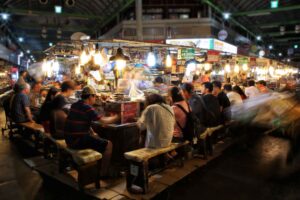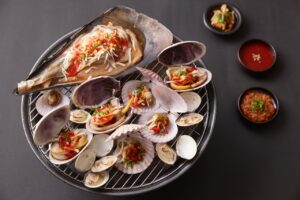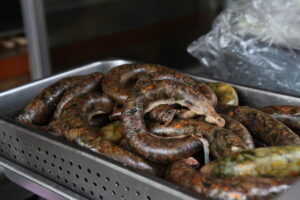-
PojangMacha is small tented street restaurant in Korea

What is the Pojangmacha in Korea?A Pojangmacha(Pocha) is a small mobile restaurant that symbolizes a popular street food culture in Korea. It is mainly covered with tents and sells simple food and alcohol. Pochas are mainly operated in the evening or at night, and are common in Korean cities and tourist attractions.
history
The origins of the Pochas go back to a time when the economy was struggling after the Korean War, when many people began to sell food on the streets for a living, which gradually developed into the current stall form.
## Features
1. **Food Type**:
– ** Snacks ***: Snacks such as tteokbokki, sundae, tempura, fish cake are typical.
– ** Seafood ***: Fresh seafood dishes such as sea bream, mountain octopus, and shellfish are also common.
– ** Grilled meats **: Various grilled dishes such as chicken skewers, beef skewers, and eel roast are served.
– ** Other ***: Snacks such as hokok, chestnuts, and bamboo bread are often seen in Pochas.
2. *** Drinks*:
– **Shochu **: It is the most popular drink in the Pocha.
– ** Makgeolli **: Traditional makgeolli and various flavors of makgeolli are also enjoyed in Pochas.
– ** Beer **: Beer is also available for simple enjoyment.
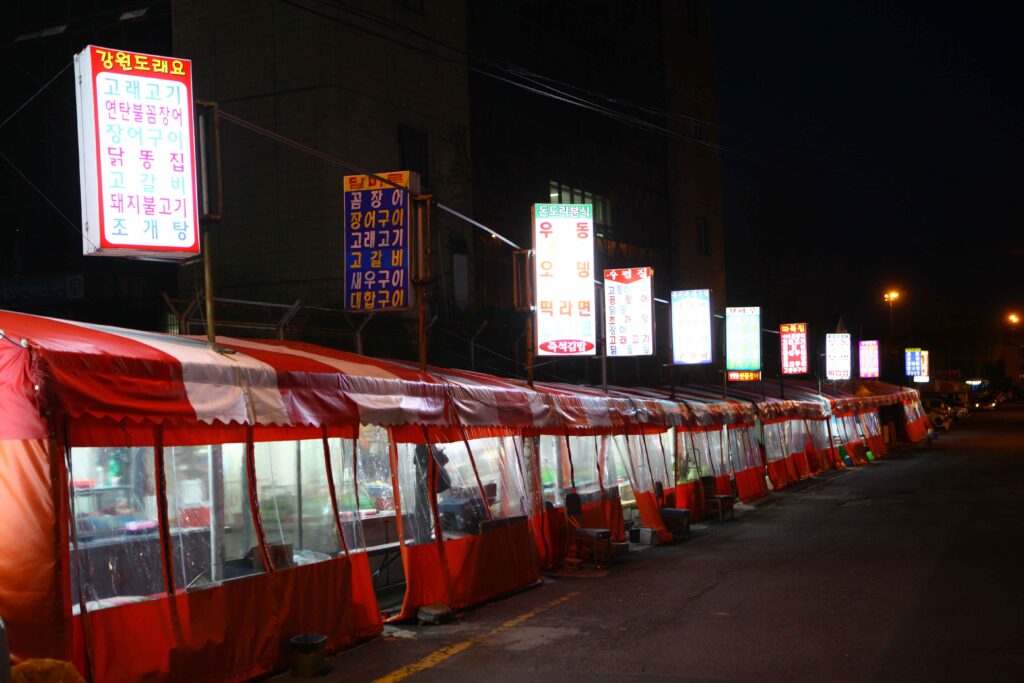
PojangMacha in Korea Mood of Pojangmacha?
The stalls boast a friendly and relaxed atmosphere; the seating mainly consists of simple plastic chairs and tables, and many enjoy food in a folksy and casual atmosphere. Here, you can naturally talk to people and enjoy social exchanges.
## cultural meaning
The food stand is not just a place to sell food, it is an important cultural space for Koreans, and it plays a big role as a place to relieve daily stress and hang out with friends and colleagues. In addition, the stall is a place that often appears in Korean dramas and movies, and it is an important element that shows one side of Korean culture.
## Change and Modernization
In recent years, stalls have been changing; in addition to traditional stalls, food truck-type stalls with modern designs and a variety of menus are also emerging, which are becoming popular with younger generations and tourists.
The stalls are an important part of Korean street food culture and everyday life, and they are also very attractive to tourists visiting Korea.
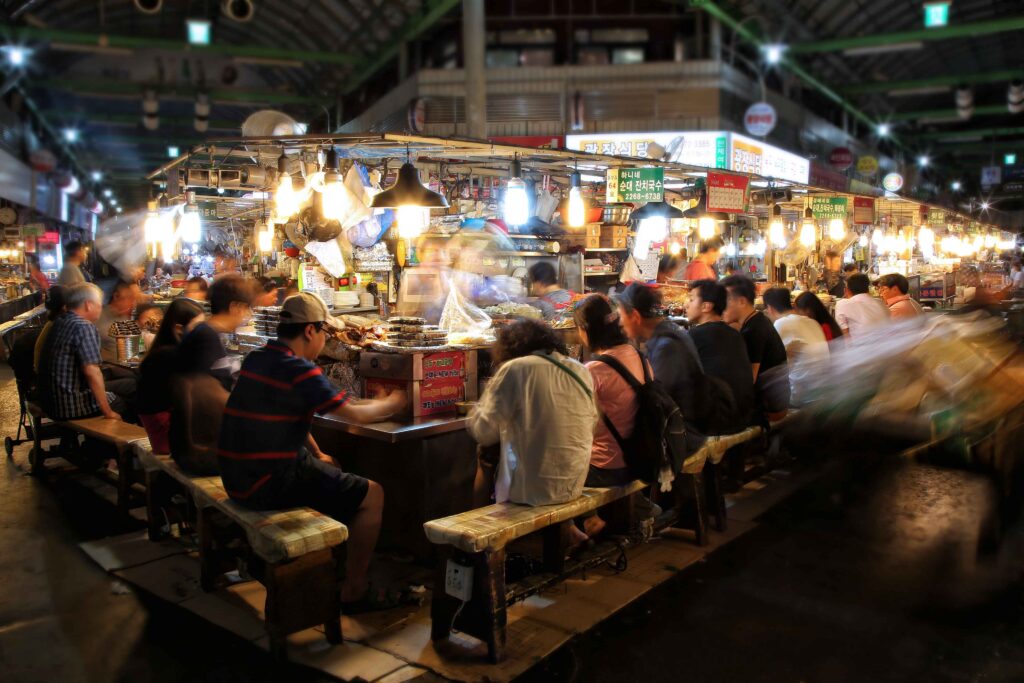
Pojan Macha in Korea Typical places to experience stalls in Korea are as follows:
Seoul- ** Plaza Mayor**:
- As one of the traditional markets in Seoul, you can enjoy a variety of stalls and street food, especially Bingdae cakes, sashimi, and tteokbokki.
- *Myeongdong:
- Myeongdong street is the center of shopping and sightseeing, and there are various stalls along the street, so you can taste tteokbokki, hokok, and tempura.
- ** Namdaemun Market **:
- Namdaemun Market is also a traditional market, where you can enjoy cheap shopping with a variety of stalls.
- ** Hongdae*:
- At night in front of Hongdae where many young people gather, stalls line up and provide a variety of food.
Busan
- ** Nampo-dong*:
- It is one of the representative downtown areas of Busan, and various stalls are gathered. Especially, seed hokok and fish cake are famous.
- *Haeundae:
- There are many stalls near Haeundae Beach, especially seafood dishes.
cod
- ** same-sex road*:
- It is the central downtown area of Daegu where you can enjoy food with various stalls.
- ** Preface to Market **:
- One of the largest traditional markets in Daegu, especially the night market is famous, so you can taste various stalls.
Gwangju
- *Chungjangro:
- It is the central business district of Gwangju, where you can easily find street food and stalls.
- ** Yangdong Market **:
- It is a traditional market in Gwangju, where you can experience stalls with various foods.
Incheon
- ** Shinpo International Market **:
- One of Incheon’s traditional markets, you can enjoy shopping with a variety of stalls.
- ** Chinatown*:
- You can taste various stalls and street food in Incheon Chinatown.
Other areas
- ** Jeonju Hanok Village **:
- As a famous sightseeing spot in Jeonju, you can enjoy various stalls with traditional hanok.
- **Jeju Island Alumni Market **:
- It is a traditional market of Jeju Island, where you can taste Jeju specialties along with various stalls.
In these places, you can experience various Korean food stalls, hang out with locals, and enjoy Korean street food culture.
Recommend to Read >> Delicious Gamjatang Recipe: A Spicy Korean Pork Bone Stew – Korean Food Nearby
-
Miyeokguk, A special meal for your birthday in Korea in Nov 2023.
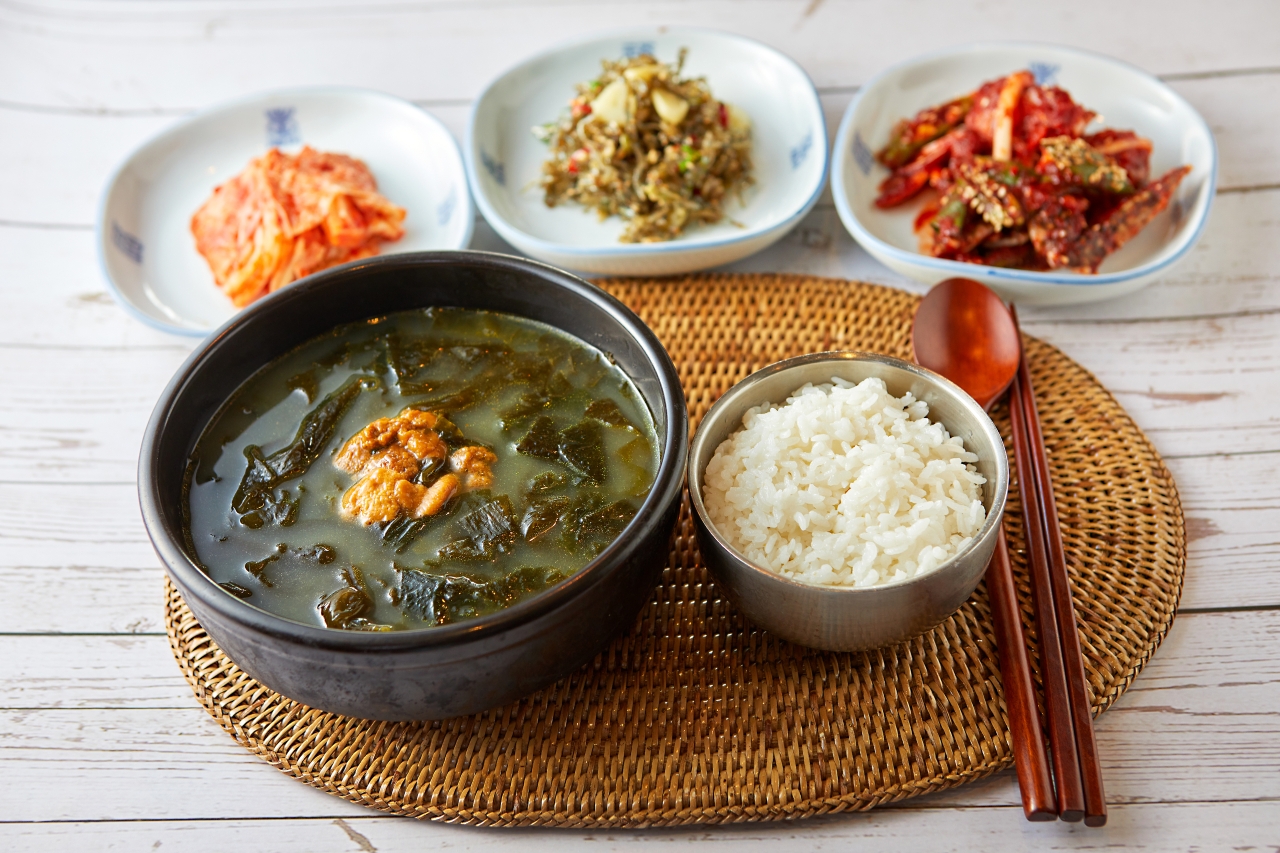
Miyeokguk, Birthday Soup.
Miyeokguk is a traditional Korean seaweed soup made with miyeok, which is a type of sea vegetable commonly known as wakame in Japanese. This soup is often associated with birthdays in Korea and is considered a comfort food. It is believed that miyeokguk is a nutritious and replenishing dish, making it a popular choice for celebrating birthdays.
The main ingredients in miyeokguk typically include miyeok (seaweed), beef or sometimes seafood, garlic, soy sauce, and sesame oil. The seaweed is first soaked and then cooked with other ingredients to create a flavorful broth. It is often garnished with thinly sliced green onions.
In Korean culture, miyeokguk is commonly consumed by new mothers during the postpartum period as it is believed to have health benefits and is thought to help with recovery. The dish is also enjoyed on birthdays as a way to symbolize growth, renewal, and the cycle of life.
It’s important to note that variations of miyeokguk exist, and the specific ingredients and preparation may vary from one region or family to another.
History
In Korean culture, the tradition of eating miyeokguk on one’s birthday is rooted in the belief that consuming this seaweed soup symbolizes the cycle of life, growth, and renewal. Miyeok, the main ingredient in miyeokguk, is rich in nutrients, including iodine, calcium, and vitamins, making it a healthy and nourishing dish.
Here are a few key aspects of the tradition:
Symbolism of Growth and Renewal: The long, slender strands of miyeok are seen as representing longevity and growth. By eating miyeokguk on their birthday, Koreans express a wish for a healthy and prosperous year ahead and symbolize the idea of growing another year older.
Remembrance of Mother’s Sacrifice: There’s also a connection between miyeokguk and the postpartum period. Traditionally, new mothers are often served miyeokguk after giving birth as it is believed to aid in recovery and provide essential nutrients. By consuming miyeokguk on one’s birthday, individuals may be acknowledging and remembering the sacrifice and care their mothers provided during their early years.
Cultural Significance: Miyeokguk has become deeply ingrained in Korean birthday celebrations, and it is considered a comforting and familiar dish. Families often come together to share a meal of miyeokguk on birthdays, reinforcing the cultural significance of the tradition.
While the tradition may vary among individuals and families, the overall theme is one of celebrating life, expressing gratitude, and wishing for a healthy and prosperous future. It’s a cultural practice that reflects the importance of food not only as sustenance but also as a symbol of cultural values and beliefs.

Miyeokguk – ⓒ한국관광공사 사진갤러리 – 디그램 Cooking Method
Making Miyeokguk involves a few key steps, and the recipe may vary slightly based on personal preferences and regional variations. Here’s a basic recipe for Miyeokguk: Ingredients:
1 cup dried miyeok (wakame seaweed) 1/2 pound beef (flank or brisket), thinly sliced 8 cups water
2 tablespoons soy sauce
1 tablespoon sesame oil
3 cloves garlic, minced
Salt to taste
Sliced green onions for garnish
Instructions:
Prepare the Miyeok (Seaweed):
Soak the dried miyeok in cold water for about 30 minutes or until it expands and becomes soft.
Rinse the soaked miyeok in cold water and cut it into bite-sized pieces.
Prepare the Beef:
Slice the beef thinly, and if you’re using brisket, it’s a good idea to parboil it for about 5 minutes to remove any impurities.
Cooking:
In a large pot, bring 8 cups of water to a boil.
Add the sliced beef to the boiling water and cook until the meat is fully cooked and tender.
Add Miyeok and Flavorings:
Once the beef is cooked, add the soaked and cut miyeok to the pot.
Add minced garlic, soy sauce, and sesame oil to the pot.
Let the soup simmer for an additional 10-15 minutes until the miyeok is tender.
Season and Serve:
Season the soup with salt to taste.
Garnish with sliced green onions before serving.
Serve Warm:
Miyeokguk is traditionally served warm and is often accompanied by a bowl of rice.
Remember that the proportions and specific ingredients can be adjusted to suit your taste. Some variations may include adding other vegetables or using different cuts of meat. The important thing is to capture the essence of the dish and its symbolic meaning in Korean culture.
Regional Characteristics
While Miyeokguk is a dish that’s enjoyed throughout Korea, there can be regional variations in the way it’s prepared. Different regions may have distinct ingredients, preparation methods, or additional elements that reflect local tastes and preferences. Here are a few potential regional characteristics of Miyeokguk in Korea: Jeju Island:
Given its coastal location, Miyeokguk in Jeju may incorporate local seafood, such as small octopus or abalone, in addition to beef. The emphasis on fresh, local ingredients is a characteristic of Jeju cuisine.
Gyeonggi Province:
In regions like Gyeonggi, which surrounds Seoul, you might find a more urban influence on the dish. People may choose to include a variety of additional vegetables or use a combination of beef and pork for a richer flavor.
Gyeongsang Province:
Gyeongsang cuisine is known for its bold and spicy flavors. Miyeokguk in this region might include additional spicy elements like red pepper flakes or gochujang (red chili paste) to add heat to the broth.
Gangwon Province:
In colder regions like Gangwon, people may prefer heartier versions of Miyeokguk with more substantial ingredients to combat the cold weather. This could include additional root vegetables or mushrooms.
Southern Regions:
In southern regions like Jeolla, where agriculture is prominent, Miyeokguk may incorporate a variety of seasonal vegetables. The soup may have a fresher and lighter taste compared to heartier versions found in colder regions.
It’s important to note that these are general observations, and individual preferences within regions can still vary widely. Miyeokguk is a dish that has cultural and personal significance, and the way it’s prepared can be influenced by factors such as family traditions, personal taste, and the availability of local ingredients. If you’re interested in exploring regional variations, it might be worthwhile to try Miyeokguk in different areas of Korea or learn from individuals who have specific regional culinary traditions.
…
…
…
Recommend to Read >>> JogaeGui, The Most Famous Shellfish Dishes Nov. 2023
-
JogaeGui, The Most Famous Shellfish Dishes Nov. 2023
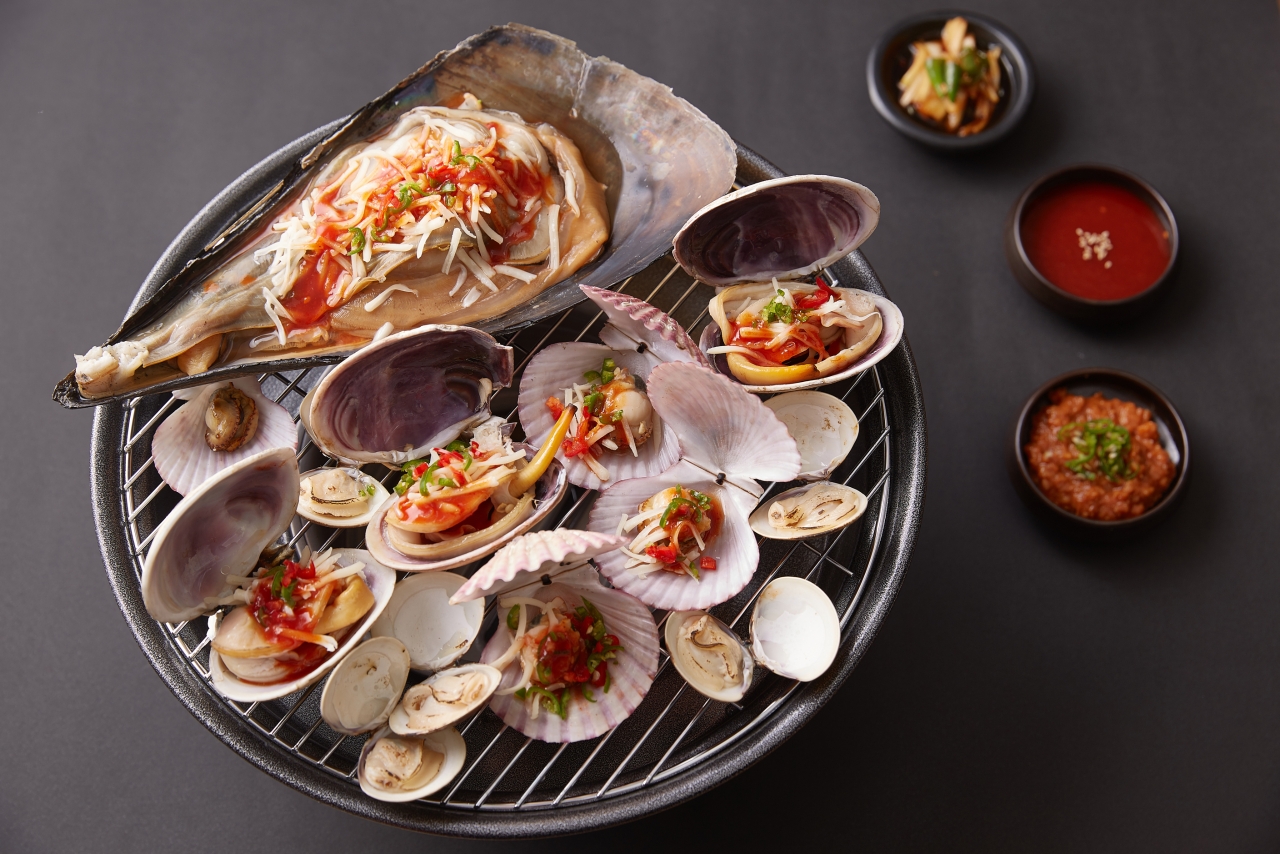
What is JogaeGui?
JogaeGui, also spelled as “Jogaegui,” is a popular Korean seafood dish that primarily consists of grilled or roasted shellfish. The term “Jogae” refers to various types of shellfish, including clams, scallops, mussels, and sometimes even oysters. These shellfish are typically seasoned with a mixture of garlic, ginger, soy sauce, sesame oil, and other flavorful ingredients before being cooked over an open flame or on a grill.
JogaeGui is known for its savory and slightly sweet flavor, often enhanced by the smokiness from the grilling process. It’s a favorite seafood dish in Korean cuisine and is often enjoyed as an appetizer or side dish, complementing other Korean dishes like barbecue (e.g., bulgogi) or served alongside rice and various banchan (side dishes). The exact preparation and seasoning of JogaeGui can vary depending on the region and the chef’s preferences, but it generally highlights the natural taste of the shellfish while adding delightful Korean flavors.
Jogae is common in Korea.
Korea’s long coastline and geographical location have contributed to the abundance of various types of seafood, including Jogae (shellfish), in Korean cuisine. Here are several factors that help explain why Koreans have a strong tradition of consuming Jogae and other seafood:
Coastal Location: Korea is a peninsula with an extensive coastline along the Yellow Sea and the East Sea (Sea of Japan). This coastal geography provides easy access to a wide variety of seafood, including various types of shellfish.
Fishing Tradition: Fishing has been an important part of Korean culture and livelihood for centuries. The Korean people have a long history of fishing in their coastal waters, which has helped make seafood, including shellfish, readily available.
Seasonal Availability: Shellfish, such as clams and mussels, are available year-round in Korea, making them a consistent and reliable source of protein for the Korean diet. Different species of shellfish are available in different seasons, ensuring a varied seafood selection.
Culinary Creativity: Koreans have developed a rich culinary tradition that showcases their creativity and ability to transform local ingredients into delicious dishes. This includes a wide range of preparations for shellfish, like JogaeGui, in various flavorful and inventive styles.
Health Benefits: Seafood, including shellfish, is known for its nutritional value and health benefits. Koreans have recognized the nutritional advantages of seafood and have incorporated it into their diet for its protein, omega-3 fatty acids, and other essential nutrients.
Cultural Significance: Seafood, including shellfish, holds cultural significance in Korean society. It is often a part of traditional Korean celebrations and is considered a symbol of abundance and prosperity.
Given these factors, the Korean people have developed a strong tradition of incorporating Jogae and other seafood into their diet, resulting in a wide array of delicious and culturally significant seafood dishes in Korean cuisine.
Kinds of Jogae in Korea.
Korea is known for its diverse selection of Jogae, which refers to various types of shellfish. Here are some common types of Jogae found in Korean cuisine: Geoduck (개불): Geoduck is a large saltwater clam with a long, neck-like siphon. It is typically sliced thin and enjoyed fresh, often served as sashimi or in salads.
Jogae (조개): The term “Jogae” itself is a general term that encompasses various types of shellfish. Common examples include clams, mussels, and scallops.
Gul (굴): Gul refers to oysters, which are often enjoyed grilled, in stews, or as a topping for rice dishes.
Manila Clams (바지락): These small, sweet clams are a popular ingredient in various Korean dishes, such as seafood stews and stir-fried dishes.
Blood Cockles (홍합): Blood cockles are known for their distinctive red coloring and are used in a variety of Korean dishes, including soups and rice dishes.
Sea Snails (소라): Sea snails are often enjoyed as a snack or appetizer in Korean cuisine. They are typically marinated or seasoned before consumption.
Scallops (가리비): Scallops are frequently used in dishes like JogaeGui (grilled shellfish) and are also included in various seafood stews.
Razor Clams (가두리): These long, slender clams are popular in Korean cuisine, particularly in grilled dishes.
Abalone (전복): Abalone is considered a delicacy in Korean cuisine and is often served in a variety of preparations, such as sashimi, porridge, and grilled dishes.
Cockles (소라): Cockles, similar to blood cockles, are used in various dishes, including seafood stews and salads.
These are just some examples of the many types of Jogae found in Korea. Each type of shellfish is used in various recipes and dishes, and the versatility of shellfish in Korean cuisine is a testament to the rich culinary traditions of the country.
Best Place in Korea
JogaeGui is a popular seafood dish in South Korea, and you can find it at various seafood restaurants and markets throughout the country. Some places are particularly famous for their JogaeGui due to the quality and freshness of the shellfish, as well as the skill of the chefs. Here are a few well-known places for enjoying JogaeGui in South Korea: Busan: Busan, a coastal city in South Korea, is renowned for its seafood, and you can find excellent JogaeGui restaurants in the Jagalchi Fish Market and other seafood markets throughout the city.
Incheon: Incheon, another coastal city, is also known for its fresh seafood. You can find JogaeGui restaurants in the Sinpo International Market and around the city’s coastal areas.
Jeju Island: Jeju Island, located off the southern coast of South Korea, is famous for its seafood, and you can enjoy JogaeGui with a view of the beautiful ocean at many restaurants on the island.
Seoul: While not as coastal as the previous locations, Seoul has a wide variety of seafood restaurants and markets where you can savor JogaeGui, often using seafood that has been transported from coastal areas.
Coastal Towns: In addition to the major cities, many smaller coastal towns and fishing villages along the South Korean coastline offer excellent JogaeGui due to their proximity to the sea.
When searching for a place to try JogaeGui, consider asking locals for recommendations or checking online reviews to find the best options for your taste and budget. Different restaurants may have their unique preparations and styles, so it’s worth exploring to find your favorite JogaeGui experience in South Korea.

Jogae Jjim – ⓒ한국관광공사 사진갤러리 – 디그램 Jogae Jjim
Jogae Jjim, also spelled as “Jogaegui Jjim,” is a popular Korean seafood dish that consists of steamed or braised shellfish. The term “Jogae” refers to shellfish, and “Jjim” means steamed or braised. Jogae Jjim is typically made with a variety of shellfish, such as clams, mussels, scallops, or other types of shellfish, depending on availability and preference.
The dish is known for its savory and aromatic flavors, often enhanced by a rich and slightly spicy sauce made from a combination of ingredients like garlic, ginger, soy sauce, red pepper flakes, and sesame oil. Vegetables like green onions and bell peppers are also commonly added to the mix, providing additional flavors and textures.
The cooking process involves steaming or braising the shellfish and the sauce together until the shellfish open up and become tender, absorbing the flavors of the sauce. Jogae Jjim is typically served as a main course or as part of a shared seafood feast, accompanied by rice and other side dishes. It’s a popular dish in Korean cuisine and is enjoyed for its delicious taste and the tender, flavorful shellfish.
…
…
…
Recommend to Read >>> Gamjatang
-
Delicious Gamjatang Recipe: A Spicy Korean Pork Bone Stew
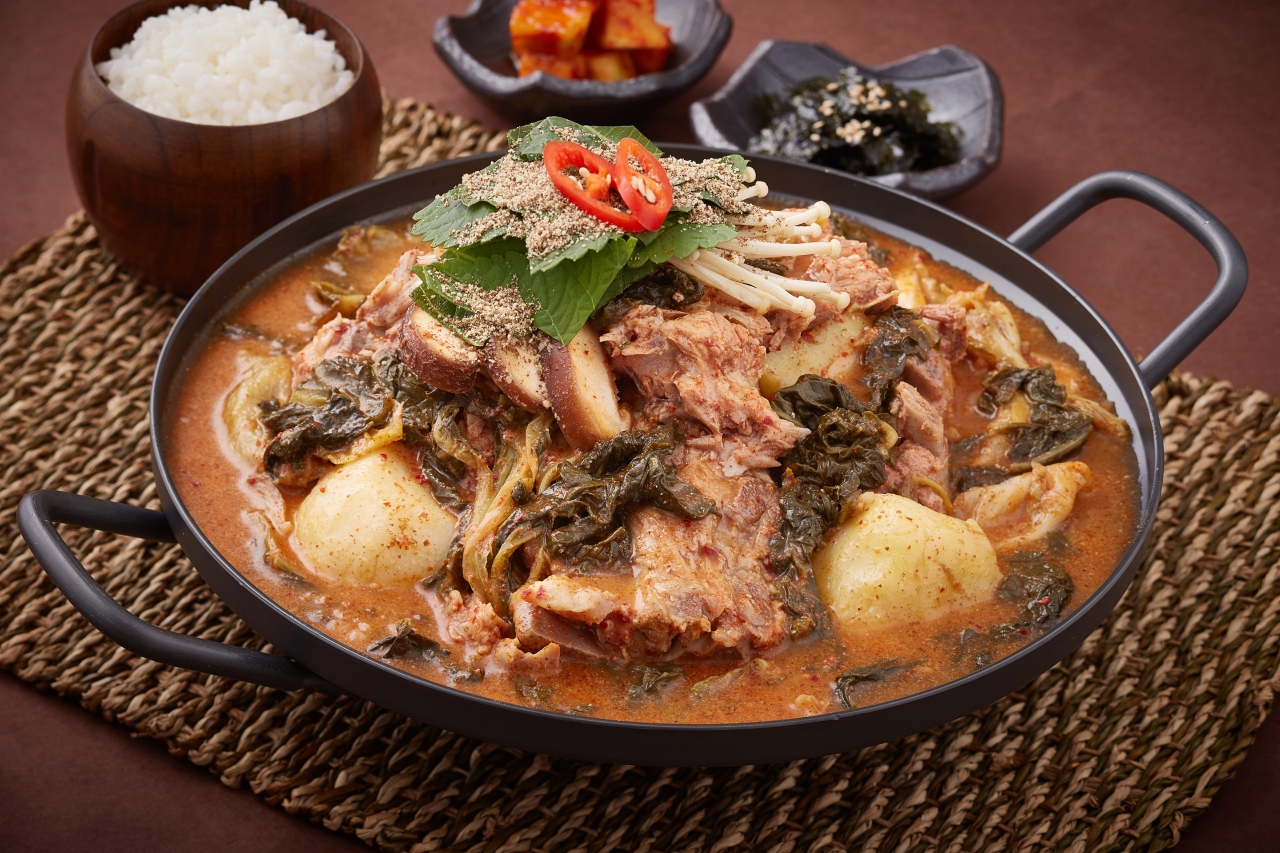
What meas of Gamjatang?
Gamjatang (감자탕) is a popular Korean soup or stew made with pork spine bones, vegetables, and a spicy broth. The name “gamjatang” comes from the Korean word “gamja,” which means potato, and “tang,” which means soup or stew. Despite the name, potatoes are not a primary ingredient in this dish.
The main components of gamjatang include:
Pork Spine Bones: These are the primary protein source in the dish. The bones are typically simmered in the broth until the meat is tender and flavorful.
Vegetables: Various vegetables such as napa cabbage, perilla leaves, bean sprouts, green onions, and sometimes mushrooms are added to the stew.
Spicy Broth: The broth is typically flavored with ingredients like gochugaru (Korean red pepper flakes), gochujang (Korean red pepper paste), garlic, and ginger, giving the dish its characteristic spiciness.
Aromatics: Garlic, ginger, and other seasonings are used to enhance the flavor of the broth.
Gamjatang is a hearty and spicy Korean dish enjoyed for its rich flavors and warming qualities, especially in colder weather. It’s often served with rice and side dishes, making it a satisfying and comforting meal.
History
The history of Gamjatang, a popular Korean dish, is intertwined with Korea’s culinary traditions and the evolution of its cuisine. While there isn’t a specific documented date of origin, we can provide an overview of its historical development.
Korean Culinary Traditions: The roots of Gamjatang can be traced back to Korea’s rich culinary heritage. Korean cuisine has a long history of using a wide variety of ingredients to create flavorful and nourishing dishes. The use of pork in Korean cuisine dates back centuries, and bone-based stews have been a part of Korean cooking for a long time.
Influence of Korean Royal Cuisine: In the Joseon Dynasty (1392-1910), Korean royal cuisine known as “yakgwa” played a significant role in shaping Korean culinary traditions. While Gamjatang may not have originated in the royal court, the emphasis on using various ingredients and spices is a hallmark of Korean cuisine, which influenced the development of dishes like Gamjatang.
Post-Korean War Era: Gamjatang, as it is known today, likely evolved in the post-Korean War era, specifically in the mid to late 20th century. During this time, South Korea was going through significant changes and rebuilding, and the cuisine adapted to the available ingredients and changing tastes.
Ingredients and Flavor Profile: Gamjatang is characterized by its use of pork spine bones, vegetables, and a spicy broth. The addition of spices, especially gochugaru (Korean red pepper flakes) and gochujang (Korean red pepper paste), reflects the spicy and flavorful nature of modern Korean cuisine. While potatoes aren’t a primary ingredient, the name “gamjatang” suggests that they may have been used historically.
Popularity and Regional Variations: Gamjatang has become a beloved dish in South Korea and is enjoyed by many for its rich, spicy flavors. It is also found in Korean restaurants around the world. Different regions and individual cooks may have their variations of Gamjatang, with slight differences in ingredients and preparation methods.
In summary, Gamjatang’s history is rooted in Korean culinary traditions, evolving over time to become the hearty and spicy pork bone stew that is widely enjoyed today. Its exact origins and the evolution of its name may not be precisely documented, but it has become an integral part of Korean cuisine and a popular dish with a rich and diverse flavor profile.

Gamjatang ⓒ한국관광공사 사진갤러리 – 이범수 The origin of the name Gamjatang
The name “Gamjatang” (감자탕) is somewhat misleading because it doesn’t actually contain potatoes (감자) as a primary ingredient. The origin of the name is not definitively known, but there are a few theories and speculations about why this dish is called Gamjatang:
Historical Linguistic Shift: One theory suggests that the name “Gamjatang” might be the result of a historical linguistic shift. It is possible that the name was originally different but evolved over time, leading to the inclusion of “gamja,” which means potato. This shift could have been influenced by the dish’s appearance or the use of other vegetables that resemble potatoes.
Metaphorical Name: Another theory is that “gamja” might be used metaphorically in this context. The term “gamja” can also mean something like “comfort” or “warmth.” So, “Gamjatang” could be understood as a comforting, warm, and hearty stew, rather than specifically indicating the presence of potatoes.
Regional Variations: The name might have originated in a specific region or local dialect, and local influences could have contributed to the choice of the name. Different regions in Korea may have slightly varying names for the same dish.
It’s important to note that the name “Gamjatang” has become widely accepted and used to describe this spicy pork bone stew in Korean cuisine, despite the absence of potatoes in the traditional recipe. The exact origin of the name remains somewhat elusive, but it’s a beloved and iconic dish in Korean cuisine known for its rich and spicy flavors.
Cooking Method
Cooking Gamjatang, the spicy Korean pork bone stew, is a relatively simple process, although it may require some time and patience to achieve the best results. Here’s a basic recipe and cooking method for making Gamjatang: Ingredients:
2 pounds of pork spine bones (you can ask your butcher to cut them into small pieces) 1/2 pound of pork belly, thinly sliced
1 small onion, sliced
6-8 cloves of garlic, minced
2 tablespoons of gochugaru (Korean red pepper flakes)
2 tablespoons of gochujang (Korean red pepper paste)
1 tablespoon of soy sauce
1 tablespoon of sesame oil
1 teaspoon of ginger, minced
Salt and pepper to taste
6-8 cups of water
Vegetables: You can use napa cabbage, perilla leaves, bean sprouts, green onions, and other vegetables of your choice.
Instructions:
Blanch the Pork Spine Bones: Place the pork spine bones in a large pot of boiling water. Let them boil for about 5 minutes, then drain and rinse them. This helps remove any excess blood or impurities.
Prepare the Spicy Broth: In a large pot, heat the sesame oil over medium heat. Add minced garlic and ginger, and sauté for a minute until fragrant. Add the gochugaru (Korean red pepper flakes) and gochujang (Korean red pepper paste) and stir-fry for another couple of minutes to release their flavors.
Add the Pork: Add the sliced pork belly to the pot and stir-fry until it starts to brown and become slightly crispy.
Add Water: Pour in 6-8 cups of water (or enough to cover the ingredients) and bring it to a boil. Skim off any impurities or foam that rise to the surface.
Simmer the Pork Bones: Add the blanched pork spine bones to the pot. Reduce the heat to a simmer and let the stew cook for about 30-40 minutes, or until the pork bones are tender and the broth has developed a rich flavor. You can cover the pot, but leave a small gap for steam to escape.
Add Vegetables: Add the sliced onions and any vegetables you prefer to the pot. Napa cabbage, perilla leaves, and bean sprouts are common choices. Simmer for an additional 10-15 minutes, or until the vegetables are tender.
Season: Season the Gamjatang with soy sauce, salt, and pepper to taste. Adjust the spiciness and seasoning according to your preference.
Serve: Gamjatang is typically served hot in a large communal pot. You can ladle it into individual serving bowls and serve it with steamed rice and side dishes.
This is a basic recipe for Gamjatang, but you can adjust the ingredients and seasonings to suit your taste. Gamjatang is often enjoyed with kimchi and other banchan (Korean side dishes) to complement its rich and spicy flavors.
…
…
…
Recommend to Read >>> Sundae, Traditional Korean Blood Sausage.
-
Bungeoppang, Fish shaped Pastry in Korea.

What is Bungeoppang?
Bungeo-ppang (봉어빵) is a popular Korean snack or street food. It is a fish-shaped pastry typically filled with sweet red bean paste, although there are also variations with other fillings such as custard, chocolate, or even cheese. The name “bungeo-ppang” literally translates to “carp bread,” and it is called so because of its fish-like shape.
The pastry is made using a special mold that resembles a fish, and the batter is poured into this mold, with the sweet filling added before closing the mold. Then, it is cooked until the outside becomes crispy and golden while the inside remains soft and sweet. Bungeo-ppang is often enjoyed during the colder months, as the warm, sweet filling is comforting in chilly weather.
Bungeo-ppang is a nostalgic and popular snack in South Korea and can be found at street food stalls, markets, and even in some bakeries. It’s a delightful treat for those who have a sweet tooth and enjoy exploring different types of street food.

Bungeo-ppang2 ⓒ한국관광공사 사진갤러리 한국관광공사 브이앤드 History
Bungeoppang, often referred to as “fish-shaped bread” in English, is a popular South Korean street food known for its unique fish-shaped appearance. Its history dates back to the early 20th century. Here’s a brief history of Bungeoppang:
Japanese Origin: Bungeoppang is believed to have originated in Japan during the Japanese colonial period (1910-1945) when Korea was under Japanese rule. The concept of a fish-shaped pastry was brought to Korea during this time, and it was adapted to Korean tastes.
Development in Korea: After its introduction, Bungeoppang underwent several modifications to suit the Korean palate. Instead of the traditional Japanese ingredients, Koreans started using red bean paste, a common filling in Korean pastries, as the primary filling. This change in filling made the snack distinctly Korean.
Rise in Popularity: Bungeoppang gained popularity as a street food snack in South Korea, becoming a staple in Korean markets and street food stalls. The fish shape, typically featuring a carp, symbolizes good luck and abundance in Korean culture, making it a popular choice for both locals and tourists.
Variations and Modernization: Over the years, Bungeoppang has evolved, and variations with different fillings, such as custard, chocolate, and even cheese, have emerged. Modern cooking techniques and equipment have also improved the preparation and consistency of this beloved snack.
Seasonal Treat: Bungeoppang is often associated with the colder months in Korea, as the warm, sweet filling provides comfort and warmth during chilly weather. However, it is enjoyed year-round and is a symbol of Korean street food culture.
Global Influence: Bungeoppang has gained recognition beyond South Korea, especially in countries with a Korean diaspora and in some parts of Asia. It has become a popular treat at Korean festivals and events worldwide.
Today, Bungeoppang is not just a delicious snack but also a cultural icon representing the fusion of Japanese and Korean culinary influences and the creativity of Korean street food vendors. Its history reflects how food can adapt and transform over time while maintaining cultural significance.
Cooking Method
Making Bungeoppang at home can be a fun and delicious culinary adventure. You’ll need a special fish-shaped mold to achieve the characteristic shape, and the following is a basic recipe for making Bungeoppang with a sweet red bean paste filling:
Ingredients:
For the Batter:
1 cup all-purpose flour
2 tablespoons sugar
1/2 teaspoon baking powder
1/4 teaspoon salt
1 egg
1 cup milk
1/2 teaspoon vanilla extract
For the Filling:
Sweet red bean paste (you can buy this pre-made at an Asian grocery store or make it from scratch) Instructions:
Prepare the Batter:
In a mixing bowl, combine the all-purpose flour, sugar, baking powder, and salt.
In a separate bowl, whisk the egg and add milk and vanilla extract.
Gradually pour the wet ingredients into the dry ingredients, stirring until the batter is smooth and well combined. The batter should be relatively thin, similar to pancake batter. If it’s too thick, you can add a bit more milk.
Heat the Bungeoppang Mold:
Preheat your fish-shaped Bungeoppang mold on the stovetop. You can lightly grease the mold with cooking oil to prevent sticking.
Fill the Molds:
Pour a small amount of the batter into the bottom half of the fish mold, making sure to cover the entire surface.
Add a spoonful of sweet red bean paste in the center of the batter, but don’t let it touch the edges of the mold.
Close the Mold:
Carefully close the top half of the fish-shaped mold onto the bottom half, sandwiching the red bean paste between the batter.
Cook the Bungeoppang:
Place the closed mold on the stovetop and cook over medium heat. You may need to rotate the mold occasionally to ensure even cooking.
When the batter becomes crispy and golden brown (usually in 2-3 minutes), carefully flip the mold to cook the other side until it’s golden brown as well.
Remove and Serve:
Carefully open the mold, and your Bungeoppang should have a beautiful fish-shaped appearance.
Remove the Bungeoppang from the mold and let it cool for a minute before serving.
Enjoy your homemade Bungeoppang! Remember that you can experiment with different fillings and even add a touch of creativity to make this classic Korean snack your own.
Where to buy it in Korea?
You can find Bungeoppang in South Korea at a variety of places, as it’s a popular street food and snack. Here are some common places where you can buy Bungeoppang:
Street Vendors and Markets: Bungeoppang is a quintessential Korean street food, so you’ll often find street vendors selling it at bustling markets, near tourist attractions, and in popular food streets.
Food Stalls at Festivals: If you’re visiting during a festival or cultural event, there will likely be food stalls that offer Bungeoppang, along with other Korean street foods.
Convenience Stores: Many convenience stores in South Korea sell pre-packaged Bungeoppang, making it easy to grab and go.
Bakeries: Some bakeries may offer their own versions of Bungeoppang, both the traditional red bean paste-filled ones and modern variations with different fillings.
Specialty Bungeoppang Shops: In larger cities like Seoul, you might also come across specialty shops dedicated to Bungeoppang. These shops may offer a wide range of flavors and fillings.
Traditional Markets: Traditional markets are excellent places to find authentic Bungeoppang made by local vendors who have been perfecting their recipes for years.
Tourist Areas: If you’re in a touristy area, Bungeoppang is often readily available to cater to both local and international visitors.
hen in South Korea, don’t hesitate to explore the local food scene, including street markets and stalls, to discover the best Bungeoppang vendors. It’s a delightful treat that you shouldn’t miss during your visit.
Recommend to Read >>>Top3 Famous Oyster Dishes in S.Korea
-
Sundae, Traditional Korean Blood Sausage.
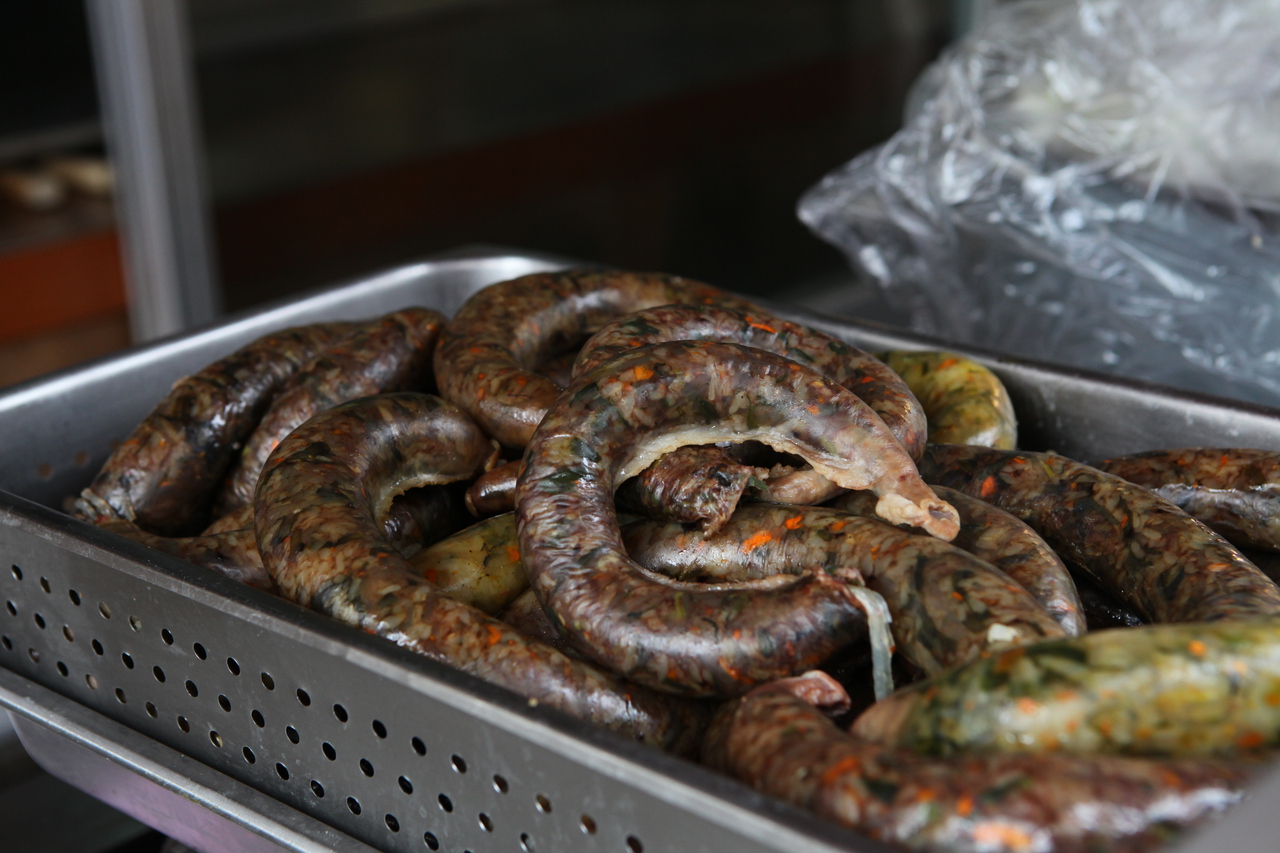
Blood Sausage, Sundae
In Korean cuisine, a “sundae” (also spelled “soondae” or “sundae”) is not a sweet ice cream dessert but rather a type of traditional Korean blood sausage. Sundae is made from a mixture of ingredients, including pig’s blood, rice, and various seasonings, stuffed into a natural casing, often made from pig intestines. The sausage is then steamed or boiled until fully cooked.
Sundae is a popular street food in South Korea, and it is also commonly served at restaurants specializing in Korean cuisine. It is known for its unique texture and flavor. The rice and blood mixture inside the sausage casing creates a soft and slightly chewy texture, and the seasonings add a savory and slightly spicy taste.
There are several regional variations of sundae in South Korea, and the specific ingredients and seasonings used can vary from place to place. Some variations may include additional ingredients like mung bean noodles, garlic, and vegetables.
One of the most famous types of sundae is “sundae guk” (sundae soup), which is made by slicing the sundae sausage into pieces and serving it in a flavorful soup. This dish is enjoyed as a hearty and comforting meal, especially during colder months.
Sundae is a distinctive and culturally significant food in Korean cuisine, and while it might not be to everyone’s taste, it is an integral part of the country’s culinary heritage. If you have the opportunity to try sundae, it can provide a unique and authentic experience of Korean street food and traditional flavors.
History
Sundae (순대) in Korean cuisine refers to a type of blood sausage. It’s different from the American dessert sundae. The history of sundae in Korean cuisine is quite fascinating and dates back centuries. Here is a brief overview of the history of sundae (순대) in Korean cuisine: Ancient Origins: The roots of sundae can be traced back to ancient Korea. Blood sausages have been made in Korea for hundreds of years, with the practice dating back to at least the Three Kingdoms period (57 BC – 668 AD).
Ingredients and Preparation: Traditional Korean sundae is typically made using pig’s intestines, pig’s blood, glutinous rice, and various seasonings. The ingredients are mixed together and stuffed into the intestine casing, creating a distinctive texture and flavor.
Regional Variations: Sundae has regional variations in South Korea. Different regions may have their own unique recipes and variations. For example, there are Sundae-guk (soup) dishes where the sundae is sliced and served in a flavorful broth.
Street Food: Sundae has been a popular street food in South Korea for a long time. You can find street vendors and food stalls selling sundae in many parts of the country. It’s often enjoyed as a quick and satisfying snack.
Cultural Significance: Sundae has cultural significance in Korean cuisine. It is often associated with traditional holidays and celebrations. It’s also considered comfort food and is enjoyed during special family gatherings.
Modern Adaptations: In modern times, sundae has evolved, and there are various adaptations and fusion dishes that incorporate sundae. It’s not just limited to street food; you can find it on the menus of restaurants and eateries across South Korea.
Export and Popularity: With the growing interest in Korean cuisine worldwide, sundae has gained some recognition outside of Korea. Korean restaurants in various countries may include sundae on their menus.
Challenges and Health Considerations: The production and consumption of sundae have faced challenges related to health and hygiene concerns. Regulations and practices have been put in place to ensure safe production. The nutritional aspects of sundae have also been a subject of interest and discussion.
Sundae (순대) is a distinctive and culturally significant dish in Korean cuisine. It reflects the culinary traditions of Korea and has continued to evolve and adapt to changing tastes and preferences over the years. If you’re interested in exploring this topic further, you can delve into the various regional recipes, cultural traditions, and contemporary adaptations of sundae in South Korea.

Sundae Gukbap ⓒ한국관광공사 사진갤러리- 알렉스분도 Various Dishes with
Sundae (순대) in Korean cuisine is a versatile ingredient that can be used in a variety of dishes. Here are some of the most popular and delicious dishes that incorporate sundae: Sundae Bokkeum (순대볶음): Sundae is often stir-fried with vegetables and various seasonings to make Sundae Bokkeum. It’s a savory and slightly spicy dish that’s commonly served as a side dish or a snack.
Sundae Guk (순대국): Sundae can be sliced and used as an ingredient in a flavorful soup, known as Sundae Guk. The soup is typically made with a rich broth and various seasonings, making it a warm and comforting meal.
Tteokbokki (떡볶이): Tteokbokki is a popular Korean street food made with rice cakes and a spicy gochujang-based sauce. Sundae is often added to tteokbokki, providing a unique texture and flavor to the dish.
Sundae Deopbap (순대덮밥): Sundae Deopbap is a rice bowl dish where sliced sundae is served over a bed of rice and drizzled with a flavorful sauce. It’s a filling and satisfying meal.
Jeon (전): Sundae can be used as an ingredient in Korean pancakes known as “jeon.” These savory pancakes are made by dipping sundae and other ingredients in a batter and frying until crispy.
Sundae Gimbap (순대김밥): Sundae can also be used as a filling for gimbap, which are Korean rice rolls wrapped in seaweed. Sundae gimbap combines the flavors of sundae with rice, vegetables, and seasonings.
Sundae Skewers: Sundae can be threaded onto skewers and grilled or roasted, often brushed with a flavorful sauce. This makes for a delicious and convenient street food or appetizer.
Sundae Tteok (순대떡): Sundae can be combined with rice cakes to create a unique and tasty dish. The combination of chewy rice cakes and savory sundae is a popular choice.
Sundae Fried Rice (순대볶음밥): Sundae can be diced and used as an ingredient in fried rice. Sundae fried rice typically includes vegetables, seasonings, and, of course, sundae for a distinctive flavor.
Sundae Stew (순대찌개): Sundae can also be added to Korean stews. Sundae stew combines the flavors of sundae with tofu, vegetables, and a flavorful broth.
These are just a few examples of the many ways sundae can be incorporated into Korean cuisine. Its unique texture and savory flavor make it a versatile and beloved ingredient in various Korean dishes, both traditional and modern.
…
…
…
Recommend to Read >>> Tofu in Korea
-
3 Delicious Tofu Dishes

History of TofuThe history is long and can be traced back to ancient China. Here is an overview of the historical development of tofu:
Origins in China: Tofu, or bean curd, is believed to have originated in China over 2,000 years ago. The exact date of its invention is not well-documented, but it is thought to have been discovered during the Western Han Dynasty (206 BC to 9 AD) or possibly even earlier. One legend attributes its creation to Prince Liu An, a Han Dynasty royal.
Spread to Other Asian Countries: Making and consumption gradually spread to other East Asian countries, including Japan, Korea, and Vietnam. Each of these cultures developed their own variations of tofu and incorporated it into their cuisines.
Buddhist Monasteries: The one gained popularity among Buddhist monks and vegetarians in China and later in other Asian countries due to its high protein content and suitability for meatless diets. Buddhist monasteries played a significant role in both popularizing it and refining making techniques.
Ming and Qing Dynasties: During the Ming (1368-1644) and Qing (1644-1912) Dynasties in China, tofu production and consumption continued to expand, and a variety of tofu products were developed.
Introduction to the West: It was introduced to the Western world in the early 20th century, primarily through Chinese and Japanese immigrants. Initially, it was primarily consumed by Asian communities in the West.
Popularity in the West: It started gaining popularity in the West during the mid-20th century, especially during the rise of the vegetarian and health food movements. The 1960s and 1970s saw an increase in interest in tofu as a protein source in vegetarian and vegan diets.
Industrialization and Commercialization: With the growing demand for tofu in the West, tofu production became industrialized, and it became readily available in supermarkets and health food stores.
Global Acceptance: Tofu has now gained global acceptance and is widely consumed in various cuisines and dietary preferences. It is valued not only for its nutritional content but also for its versatility as an ingredient that can be used in a wide range of dishes.
Today, tofu is enjoyed by people around the world and continues to be a staple in Asian cuisines. Its long history and adaptability have made it a popular and enduring food product.How to make it?
Making it from scratch at home can be a rewarding process, but it requires some time and patience. Here’s a simplified guide to making homemade one. Keep in mind that this is a basic recipe, and there are variations and techniques to explore as you become more experienced.
Ingredients:
- Dried soybeans (1 cup)
- Water (4 cups for soaking, plus additional for blending)
- Coagulant (e.g., magnesium chloride, calcium sulfate, or Epsom salt)
- Nigari (a common coagulant option, available in health food stores) or lemon juice can be used as an alternative
Equipment:
- Blender
- Large pot
- Cheesecloth or a tofu mold
- Heavy weight (such as a can or a tofu press)
Instructions:
- Soak the Soybeans:
- Rinse the dried soybeans and soak them in 4 cups of water for at least 8 hours or overnight. This will soften the beans.
- Make Soy Milk:
- Drain and rinse the soaked soybeans.
- Blend the soaked soybeans with 4 cups of water until you have a smooth, thick mixture.
- Strain the Soy Milk:
- Place a large pot on the stove and line it with cheesecloth or a clean cloth.
- Pour the blended mixture through the cloth to strain out the soy milk. Squeeze the cloth to extract as much liquid as possible. The liquid you obtain is soy milk.
- Heat the Soy Milk:
- Heat the soy milk in the pot over medium heat, stirring constantly to prevent sticking or burning. Heat it until it almost comes to a boil (around 180-185°C or 82-85°F). Remove it from the heat once it’s hot but not boiling.
- Add Coagulant:
- Dissolve your chosen coagulant (e.g., nigari) in a small amount of warm water.
- Slowly add the dissolved coagulant to the hot soy milk while gently stirring. The soy milk will begin to curdle.
- Curds and Whey:
- Allow the curds to form for about 15-20 minutes. You’ll see solid curds and a greenish liquid (whey) separating.
- Strain and Mold:
- Line a tofu mold or a small container with cheesecloth.
- Carefully ladle the curds into the mold.
- Press :
- Fold the cheesecloth over the tofu, place a weight (such as a can) on top, and let it press for 15-30 minutes. The longer you press, the firmer the tofu will be.
- Unmold and Store:
- Gently remove that from the mold, unwrap it, and store it in water in an airtight container in the refrigerator. Change the water daily to keep it fresh.
Homemade one may have a slightly different texture and flavor compared to store-bought varieties, but it can be quite rewarding to make your own. Experiment with different coagulants and pressing times to achieve it consistency you prefer.

Chodang Soon Tofu ⓒ한국관광공사 사진갤러리-디그램 1. Soon Tofu Jjigae
Soon Tofu, also known as Sundubu or Soft Tofu Stew, is a popular Korean dish known for its spicy and flavorful broth and its use of soft or silken tofu as a key ingredient. The dish typically includes a variety of other ingredients such as vegetables, mushrooms, and protein sources, which can vary depending on personal preferences and regional variations. Soon Tofu is known for its comforting, warming, and spicy qualities.
Here are the basic components of a typical Soon Tofu dish:
Soft Tofu: The star of the dish is the soft or silken tofu. This type of tofu has a delicate and creamy texture that adds a velvety consistency to the stew. It’s often added directly to the simmering broth.
Spicy Broth: The broth is a spicy and savory base, usually made with gochugaru (Korean red pepper flakes), gochujang (Korean red pepper paste), soy sauce, and other seasonings. It’s the spicy element that gives Soon Tofu its distinctive flavor.
Ingredients: Additional ingredients are often added to the stew, which can include vegetables (such as zucchini, mushrooms, and onions), seafood (like clams, shrimp, or mussels), and/or meat (commonly pork or beef). Toppings like green onions, enoki mushrooms, and an egg can also be added.
Customization: Soon Tofu is highly customizable. Diners can often choose their preferred level of spiciness, protein, and other ingredients to suit their taste.
Serving: It is typically served hot in a stone or earthenware pot. The stew continues to simmer at the table, and diners can enjoy it directly from the pot.
Accompaniments: It is usually served with a bowl of steamed rice and an assortment of banchan (small side dishes) to complement the flavors.2. Tofu Kimchi
“Tofu Kimchi” is not a traditional or common Korean dish. However, it seems like you might be referring to a dish that combines tofu with kimchi, a popular and spicy Korean side dish made from fermented cabbage and other vegetables. This combination is not unusual and can result in a flavorful and satisfying dish. Here’s how you can make a simple dish that combines tofu and kimchi:
Ingredients:
Firm or extra-firm tofu, cut into cubes
Kimchi, chopped
Kimchi juice (from the jar of kimchi)
Soy sauce
Sesame oil
Sesame seeds (optional)
Green onions, chopped (optional)
Red pepper flakes (gochugaru, optional, for added spiciness)
Instructions:Prepare the Tofu:
Drain and cut the tofu into bite-sized cubes.
Saute the Tofu:Heat a pan or skillet over medium heat and add a little oil. Saute the tofu cubes until they are lightly browned on all sides. Remove from the pan and set aside.
Mix Tofu and Kimchi:In the same pan, add the chopped kimchi along with a splash of kimchi juice (the liquid from the kimchi jar). You can adjust the amount of kimchi and juice based on your taste preferences.
Season the Dish:Season the mixture with soy sauce, a drizzle of sesame oil, and red pepper flakes if you want to increase the spiciness. Be cautious with the soy sauce, as kimchi is already salty, and you can adjust to taste. Stir everything together and let it cook for a few minutes until the kimchi is heated through.
Add the Tofu:Once the kimchi is heated and well-mixed with the tofu, return the sauteed tofu to the pan and stir to combine. Cook for a few more minutes until the tofu is heated through.
Garnish and Serve:Optionally, garnish the dish with chopped green onions and sesame seeds. These add some extra flavor and a bit of crunch.
Serve: Tofu kimchi can be served as a side dish or as a main course, usually with a bowl of steamed rice.This dish offers a combination of the creamy, mild tofu with the spicy and tangy flavors of kimchi. It’s a delicious way to enjoy both ingredients together. Feel free to adjust the spiciness and seasonings to your liking.
3. Tofu Jeon
Tofu Jeon, also known as “Dubu Jeon,” is a popular Korean dish made by pan-frying tofu slices coated with a savory batter. It’s a delicious and simple way to enjoy tofu, and it’s often served as a side dish or appetizer in Korean cuisine. Here’s a basic recipe for making Tofu Jeon:
Ingredients:Firm tofu (about 1/2 block or as desired)All-purpose flour Cornstarch Water Soy sauce Minced garlic Chopped green onions Salt and pepper Vegetable oil for frying
Instructions:
Prepare the Tofu:Slice the tofu block into thin rectangular pieces. You can cut them into any shape you prefer, such as squares or triangles.
Make the Batter:In a mixing bowl, combine all-purpose flour and cornstarch in a 1:1 ratio. The amount depends on the quantity of tofu you’re using, but you’ll generally want enough to coat all the tofu slices.Add water gradually and mix until you have a smooth batter with a pancake-like consistency.
Season the Batter:Add soy sauce, minced garlic, chopped green onions, salt, and pepper to the batter. Adjust the seasonings to taste.
Coat the Tofu:Dip each tofu slice into the batter, ensuring that it’s evenly coated.
Fry the Tofu:Heat vegetable oil in a skillet or frying pan over medium heat.Carefully place the battered tofu slices in the hot oil and cook until they are golden brown and crispy on both sides, about 2-3 minutes per side. You may need to work in batches depending on the size of your pan.
Drain and Serve:Remove the Tofu Jeon from the pan and place them on a plate lined with paper towels to drain any excess oil.
Serving:Tofu Jeon is often served with a dipping sauce. A simple dipping sauce can be made by combining soy sauce, vinegar, a pinch of sugar, and optional minced garlic and green onions.
Tofu Jeon is a delightful and crunchy dish that combines the soft and creamy texture of tofu with a flavorful and crispy coating. It’s a great appetizer or side dish for a Korean meal or can be enjoyed as a snack. You can customize the seasonings and dipping sauce to suit your taste.Learn More : Chodang Soon Tofu Village in Korea
Recommend to Reads >>> Oyster Dishes in Korea
-
Top3 Famous Oyster Dishes in S.Korea
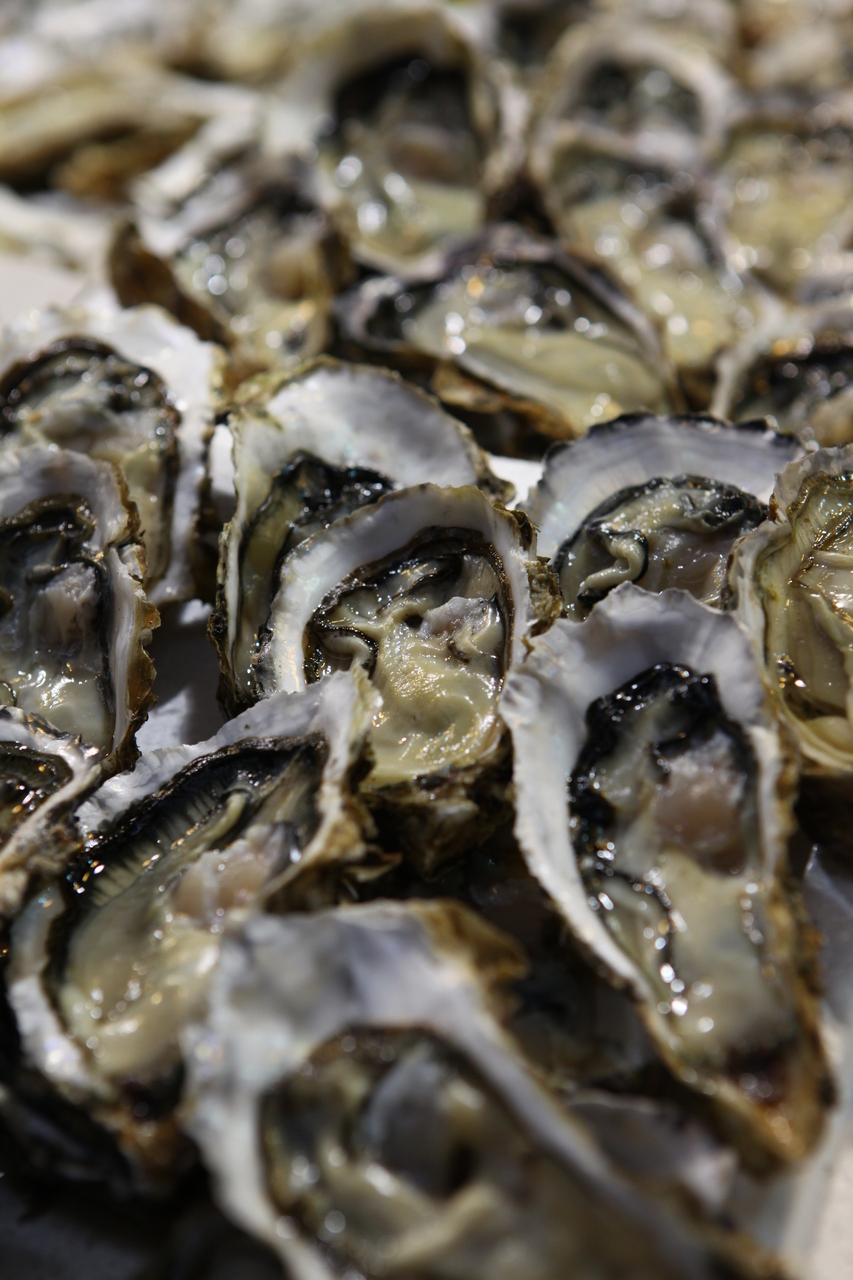
Oysters are cheap in Korea.
Korea has a rich tradition of oyster cultivation and consumption due to several factors that contribute to the abundance of them in the region:
Geographical Location: Korea’s long coastline and the presence of numerous bays and estuaries provide an ideal environment for it’s farming. The combination of warm and cold ocean currents creates a diverse marine ecosystem that supports to growth.
Tidal Flats and Mudflats: Korea is known for its extensive tidal flats and mudflats along its coastlines, which serve as natural habitats for them. These areas are ideal for it cultivation and support the development of it’s beds.
Cultural Tradition: they have been an important part of Korean cuisine for centuries. They have been consumed for their nutritional value and flavor, and as a result, it’s farming has been a longstanding practice in Korean coastal regions.
Farming: Korea has a well-developed it’s farming industry. farming involves the cultivation of it’s in controlled environments, such as tidal flats, where it can feed and grow. Korean farmers have developed techniques to optimize production.
Seafood Demand: The demand for seafood is high in Korea due to the popularity of seafood in the local diet. they are used in various traditional dishes, soups, and stews, and their abundance ensures a steady supply.
Cultural and Culinary Significance: they have cultural and culinary significance in Korea, especially during the winter months when they are in season. Various traditional dishes and festivals celebrate it, contributing to their prominence in Korean culture.
Environmental Conditions: The temperate climate and suitable water conditions in Korea provide an ideal environment for oyster growth and reproduction.
Because of these factors, they are readily available and have a strong presence in Korean cuisine. The combination of coastal geography, cultural traditions, and an established it’s farming industry has made Korea one of the prominent regions for oyster production and consumption in Asia.
Grilled Oyster ⓒ한국관광공사 사진갤러리-김지호 Nutrients
Oysters are highly nutritious and are considered a valuable source of various essential nutrients. Here are some of the key nutrients found in oysters:
- Protein: They are a rich source of high-quality protein, making them an excellent choice for those looking to meet their protein intake.
- Vitamins: They are particularly abundant in various vitamins, including:
- Vitamin B12: They are one of the best natural sources of vitamin B12, essential for nerve function and the formation of red blood cells.
- Vitamin D: They contain vitamin D, which is important for bone health, immune system function, and overall well-being.
- Minerals: They are a significant source of essential minerals, such as:
- Zinc: They are one of the richest dietary sources of zinc, which is important for immune function, wound healing, and cellular processes.
- Iron: They provide iron, a mineral essential for transporting oxygen in the blood.
- Selenium: They contain selenium, which has antioxidant properties and supports thyroid function.
- Copper: They contain copper, which is necessary for various physiological processes in the body.
- Omega-3 Fatty Acids: They are a good source of heart-healthy omega-3 fatty acids, including eicosapentaenoic acid (EPA) and docosahexaenoic acid (DHA). These fatty acids support cardiovascular health and may have anti-inflammatory effects.
- Antioxidants: Oysters contain antioxidants, such as vitamin C and vitamin E, which can help protect cells from oxidative damage.
- Phosphorus: They provide phosphorus, which is essential for healthy bones and teeth, as well as various metabolic processes.
- Selenium: They are a notable source of selenium, which is important for thyroid health and acts as an antioxidant.
- Low in Calories and Fat: Theyare relatively low in calories and fat, making them a nutritious, lean source of protein.
It’s important to note that while they are highly nutritious, they are also filter feeders and can accumulate contaminants from their environment, such as heavy metals and bacteria. As a result, it’s essential to consume oysters from reputable sources and ensure they are properly cooked or handled to minimize the risk of foodborne illnesses.
Top3 Famous Dishes in Korea
Korea offers a variety of dishes featuring that, and here are three of the most famous ones:
- Guljeon (굴전 – Pancakes): Guljeon is a popular Korean seafood pancake that prominently features it as a key ingredient. they are mixed with a batter made from flour, water, and various seasonings, and then pan-fried to create a crispy and savory pancake. It’s often served with a dipping sauce made of soy sauce and vinegar.
- Gulbap (굴밥 – Rice): Gulbap is a delicious and comforting Korean dish where fresh them are cooked with rice. The oysters are typically seasoned and mixed with rice, often flavored with soy sauce, sesame oil, and sometimes vegetables like green onions. It’s a simple yet flavorful way to enjoy the taste of them in a hearty meal.
- Gulguk (굴국 – Soup): Gulguk is a Korean oyster soup made with them, vegetables, and various seasonings. they are typically simmered in a flavorful broth along with ingredients like tofu, mushrooms, and seaweed. The result is a nourishing and savory soup with the briny taste of the oysters.
These dishes showcase the versatility of oysters in Korean cuisine and are enjoyed for their unique flavors and the taste of the sea. Oysters are often associated with the winter season in Korea, and these dishes are commonly enjoyed during that time when oysters are in season.
R-month rule
Oysters are typically considered best to eat during the months with the letter “R” in their names. This rule, known as the “R-month rule,” is a traditional guideline for oyster consumption and has historical reasons. The months without an “R” in their names are generally warmer months in many regions, and warmer waters can increase the risk of certain foodborne illnesses associated with oysters, such as bacterial contamination.
In the Northern Hemisphere, this rule translates to avoiding oysters during the summer months, typically from May to August. However, it’s essential to note that modern oyster harvesting and handling practices, along with strict regulations and refrigeration, have improved food safety and made it possible to enjoy oysters year-round without significant risk.
Many oyster enthusiasts continue to eat oysters throughout the year, even during the “non-R” months, as long as they are sourced from reputable suppliers and handled and stored properly to minimize the risk of foodborne illnesses. It’s advisable to follow local regulations and guidelines regarding oyster safety and to be cautious when consuming raw oysters, especially during warmer months when the risk of contamination may be slightly higher. Cooking oysters thoroughly is another way to reduce the risk of foodborne illness if you have concerns about consuming raw oysters.
…
…
…
Recommend to Read >>> Mandu(Korean Dumpling)
-
Dumplings(Mandu) replace 49 head sacrifices.
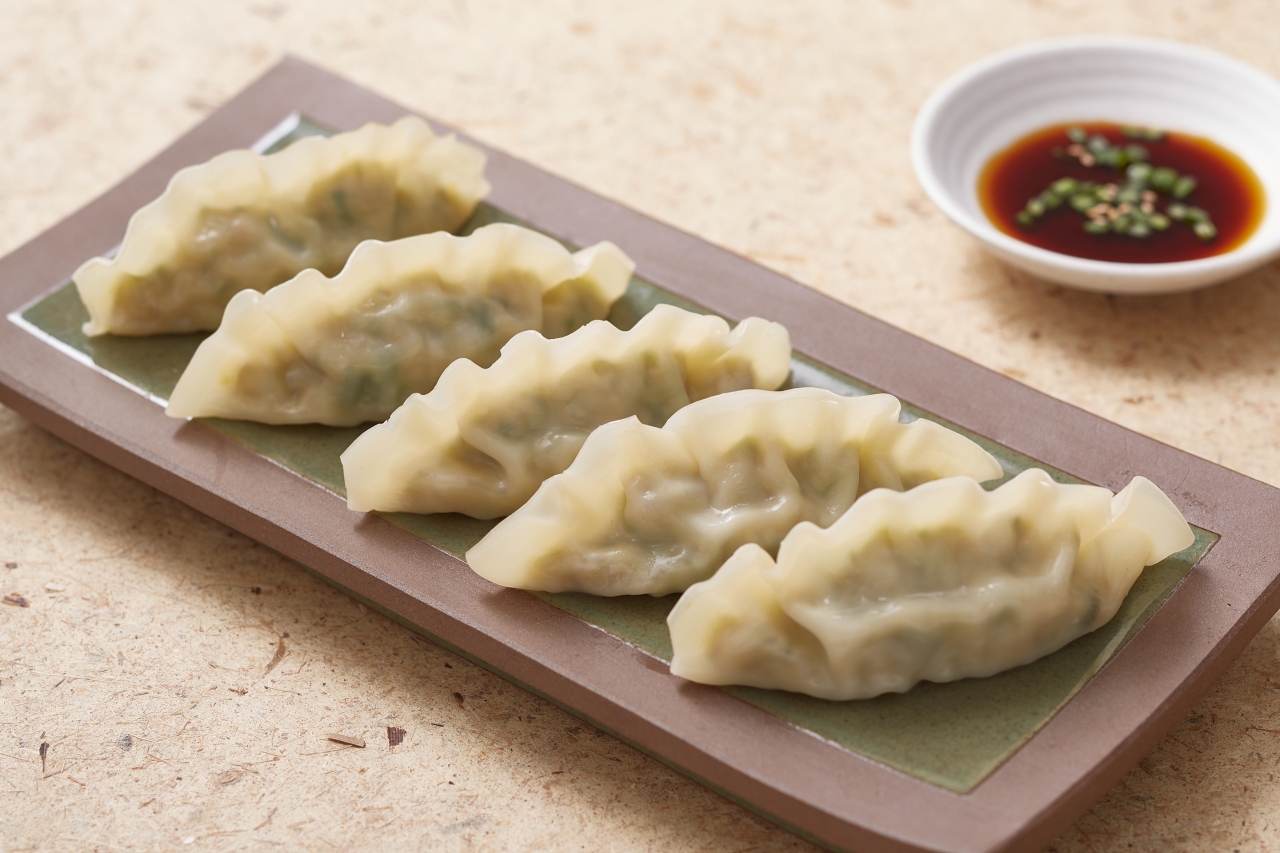
Mandu Popular Korean Dish
Mandu is a popular Korean dish that consists of dumplings typically filled with various ingredients like meat, vegetables, tofu, or kimchi. It has a long and fascinating history dating back centuries. Here’s a brief overview of the history of Mandu:
Ancient Origins: Dumplings in various forms have been part of Korean cuisine for centuries. It’s believed that the concept of Mandu was introduced to Korea from China via the Silk Road, along with various culinary and cultural exchanges.
Goguryeo Dynasty (37 BC – 668 AD): It is thought to have gained popularity during the Goguryeo Dynasty. In ancient times, these dumplings were primarily made with meat, and they served as a convenient and portable food for travelers and soldiers.
Goryeo Dynasty (918–1392): During the Goryeo Dynasty, It started to evolve. It began to include more diverse fillings, such as vegetables and different types of meat, and was enjoyed by the royal court and common people alike.
Chosun Dynasty (1392–1910): This continued to be a staple food during the Chosun Dynasty. It was often consumed in royal palaces and was prepared in various forms, including steamed, fried, or boiled. The Chosun Dynasty era also saw the development of different regional variations of Mandu.
Japanese Colonial Period (1910–1945): The one tradition continued during the Japanese colonial period, although it faced some suppression of Korean culture and cuisine. Nevertheless, the love for Mandu endured among Koreans.
Post-Korean War Era and Modern Times: After the Korean War, it became an integral part of Korean street food culture. Street vendors began selling them in various forms, including fried, steamed, and boiled, making it accessible and affordable to the masses.
Contemporary Mandu: Today, it remains a beloved and versatile dish in Korean cuisine. It is enjoyed in countless variations, from kimchi Mandu to vegetarian options. It is not only a popular street food but also a cherished comfort food often made at home.
Global Popularity: Korean cuisine, including this, has gained international recognition and popularity. Many people around the world have developed a taste for Korean dishes, and Mandu has become a favorite in Korean restaurants worldwide.
Mandu’s long history and adaptability have allowed it to evolve into a diverse and delicious dish loved by people of all ages. It continues to be an essential part of Korean culinary traditions and a symbol of the country’s rich gastronomic heritage.Zhuge Liang’s Dumpling
The claim that dumplings were birthed as Zhuge Liang’s base is a popular legend in Chinese folklore. Zhuge Liang, often referred to as Zhuge Kongming, was a renowned statesman, military strategist, and scholar during the Three Kingdoms period of Chinese history. He served as the chief strategist for the Shu Han state led by Liu Bei. While this legend is not based on historical records, it has become a part of Chinese culture and the folklore surrounding Zhuge Liang. Here’s the legend:
The Legend of Zhuge Liang and Dumplings:
On the way back from the conquest of South Korea, Zhuge Liang was tied up by severe waves and winds on the river. People say that there is a god called Hwangshin in the old man, and the god is angry, so he must throw the neck of forty-nine people into the river to cross the river safely. However, Zhuge Liang, who could not kill the unjust life, made a human head shape with flour and filled it with cow and sheep meat and offered it to the emperor. After a while, the old man became silent, and the South Koreans began to call it ‘Mandu’, which means ‘head for deceit’, thinking that it was quiet because of the food that Zhuge Liang gave. Since then, human-shaped dumplings have been passed down to the north, becoming one of China’s signature foods today, and have been passed down to Korea and Japan, making it a delicacy enjoyed by all three countries.Kinds of dumplings vary depending on the filling ingredients
Korean dumplings, known as “Mandu” (만두), come in a variety of types with fillings that vary depending on the ingredients used. These dumplings are a popular part of Korean cuisine, enjoyed in various forms. Here are some common kinds of Korean dumplings categorized by their filling ingredients:
- Kimchimandu (김치 만두):
Filled with kimchi, tofu, ground pork, and seasonings. Kimchi adds a spicy and tangy flavor to the filling.
- Gunmandu (군만두 – Fried Dumplings):
Often filled with a mixture of ground meat (usually pork or beef), vegetables, and seasonings. They are fried to achieve a crispy texture.
- Mulmandu (물만두 – Boiled Dumplings):
Typically made with a mixture of ground meat, tofu, and vegetables. They are boiled and served in a savory broth, often accompanied by vegetables and garnishes.
- Tteokmandu (떡만두 – Rice Cake Dumplings):
These dumplings contain chewy rice cake pieces along with meat, vegetables, and seasonings.
- Jjinmandu (찐만두 – Steamed Dumplings):
Filled with a combination of ground meat, vegetables, tofu, and sometimes glass noodles. They are steamed to retain a soft and moist texture.
- Yachae Mandu (야채 만두 – Vegetable Dumplings):
Filled with various vegetables like cabbage, mushrooms, carrots, and glass noodles. They are a vegetarian option.
Difference between China and Korean
Chinese dumplings and Korean Mandu share some similarities as both are filled dough pockets, but they also have several differences in terms of their preparation, fillings, shapes, and flavors. Here are some key distinctions between Chinese dumplings and Korean one:
- Filling Ingredients:
Chinese Dumplings: Chinese dumplings can have a wide variety of fillings, including pork, shrimp, beef, chicken, vegetables, and combinations of these ingredients. The flavorings often include garlic, ginger, soy sauce, and other Chinese seasonings.
Korean Style : Korean Style fillings typically include a mix of ingredients such as ground meat (pork or beef), tofu, vegetables, and sometimes glass noodles. Kimchi is a common ingredient in some varieties, giving Mandu a unique spicy and tangy flavor.- Wrapping Styles:
Chinese Dumplings: Chinese dumplings come in various shapes, with the most common being crescent or half-moon shaped. They are often pleated along the edges or sealed with a simple fold.
Korean Style: Korean Style are typically made in a round shape and are often folded in a way that results in a semi-circular or half-moon shape. They are less likely to have pleats.- Cooking Methods:
Chinese Dumplings: Chinese dumplings are commonly boiled or steamed. Potstickers are a popular variety that is pan-fried, creating a crispy bottom.
Korean Style: Korean Style are commonly boiled, pan-fried (gun Mandu), steamed (jjin Mandu), or used in soups. The cooking methods may vary depending on the specific type.- Regional Variations:
Chinese Dumplings: China has various regional dumpling varieties, each with its own unique fillings, wrappers, and cooking methods. Some well-known types include Shui Jiao, Jiaozi, and Wonton.
Korean Style: Korea also has regional Style variations, with different flavors and ingredients reflecting local preferences.- Flavor Profiles:
Chinese Dumplings: Chinese dumplings have a wide range of flavors, from savory and mild to bold and spiced, depending on the region and filling.
Korean Mandu: Korean Mandu often have a balanced and savory flavor profile. Kimchi Mandu, in particular, offers a unique spicy and tangy taste due to the use of kimchi.
Mandu ⓒ한국관광공사 사진갤러리-김지호 …
…
…
Recommend to Read >>> Jokbal
-
Ramyeon, A World of Simple and Varied Pleasures
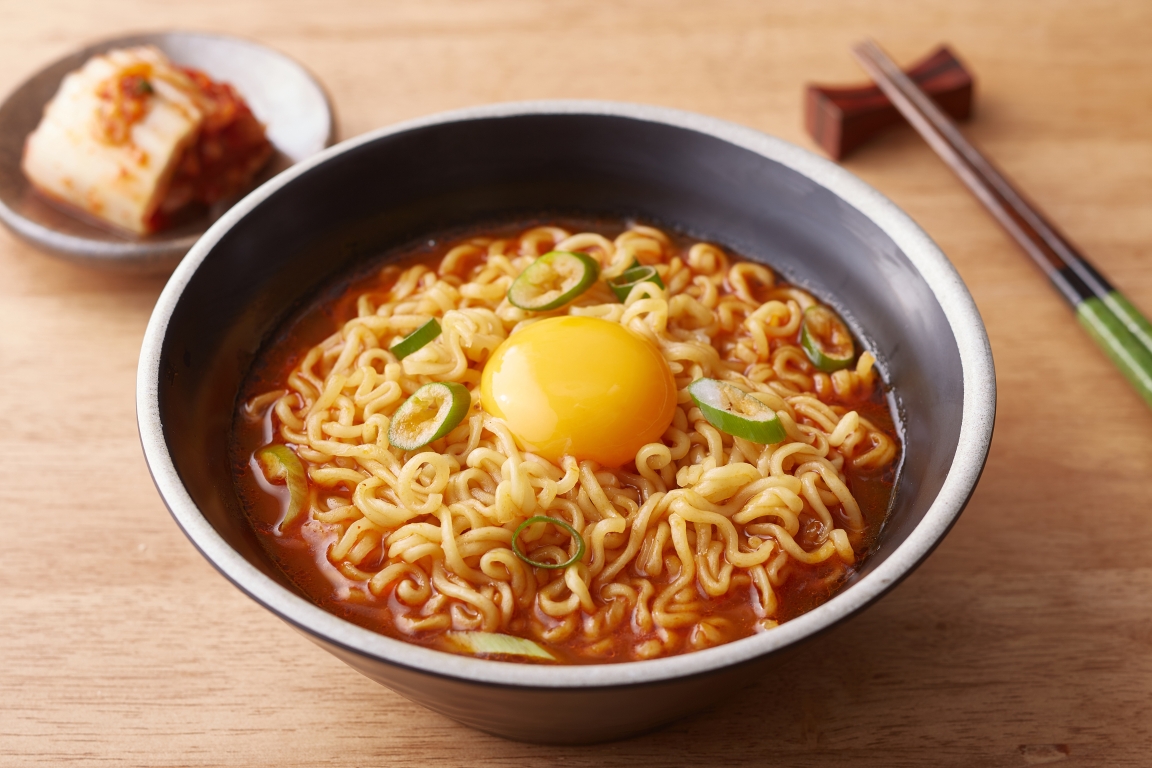
Do you like Korean Ramyeon?
The Easy Korean World of Ramen to Enjoy at Home
If you like Korea, you might have heard about ramen once.
Ramen, which can be easily enjoyed by Koreans who like soup dishes, is another pleasure in eating.
Food manufacturers such as Nongshim, Samyang, Ottogi, and Faldo are launching ramen noodles.
Today, I would like to introduce the history of ramen and the kinds of ramen by manufacturer.History
The history of ramyeon in Korea is an interesting journey that reflects the country’s culinary evolution. Ramyeon, often spelled as “Ramyeon” or “Ramen,” refers to instant noodles in Korea. Here’s a brief overview of the history of ramyeon in Korea:
- Introduction of Noodles:
- Noodles have been a part of Korean cuisine for centuries. Traditional Korean noodle dishes like “janchi-guksu” (feast noodles) and “naengmyeon” (cold noodles) have existed for a long time, but they differ significantly from modern instant ramyeon.
- Japanese Influence:
- The concept of instant noodles is largely credited to Japan. In 1958, Momofuku Ando introduced the world’s first instant noodles, which he called “Chikin Ramen.” This innovation soon led to the creation of instant ramyeon.
- Arrival in Korea:
- Instant noodles made their way to South Korea in the early 1960s, primarily through the import of Japanese products like “Nissin Ramen.” These early versions of instant noodles were foreign to Koreans but gained popularity due to their convenience and affordability.
- Korean Adaptation:
- As the popularity of instant noodles grew in Korea, local companies started developing their own brands and flavors to cater to the Korean palate. One of the first Korean instant ramyeon brands was “Samyang Ramyeon,” introduced in 1963.
- Advancements and Diversification:
- Over the years, Korean ramyeon manufacturers made significant advancements, creating a wide variety of flavors, from mild to spicy. Brands like Shin Ramyeon, developed by Nongshim, became immensely popular and are now renowned worldwide.
- Cultural Significance:
- Ramyeon has not only become a quick and convenient meal but also holds cultural significance in Korea. It is often associated with comfort food and late-night dining, especially in combination with other ingredients like kimchi, eggs, and vegetables.
- Export and Global Popularity:
- Korean ramyeon has achieved international acclaim, with brands exporting their products to various countries. Korean instant noodles are appreciated for their unique and bold flavors.
- Instant Jjapaguri from the Movie “Parasite”:
- The Korean film “Parasite,” directed by Bong Joon-ho, featured a dish called “Jjapaguri,” a combination of two popular Korean instant noodles, Jjapagetti and Neoguri. This gained worldwide attention and further increased the popularity of Korean ramyeon.
In summary, the history of ramyeon in Korea began with the introduction of instant noodles from Japan in the 1960s. Over time, it evolved into a distinct and beloved part of Korean cuisine, with a wide range of flavors and cultural significance. Korean ramyeon has not only become a quick and convenient meal option but also a symbol of comfort and nostalgia for many Koreans and food enthusiasts around the world.
Top5 Rank
- Shin Ramyun (신라면) by Nongshim:
- Shin Ramyun is one of the most iconic and beloved ramyeon brands in Korea. Known for its spicy flavor and rich broth, it’s a favorite among those who enjoy a little heat in their noodles.
- Samyang Ramyeon (삼양라면) by Samyang Food:
- Samyang Ramyeon was one of the earliest Korean instant noodle brands and is still popular for its mild and comforting flavors. It comes in various types, including Spicy Chicken Ramyeon (Buldak Ramyeon), which is famous for its fiery spiciness.
- Neoguri (너구리) by Nongshim:
- Neoguri is known for its seafood flavor and chewy udon-like noodles. It’s particularly favored by those who enjoy a slightly different ramyeon experience compared to traditional flavors.
- Jjapaguri (짜파구리):
- Jjapaguri, also known as “Jjapaguri,” gained worldwide attention after its appearance in the film “Parasite.” It’s a combination of Jjapagetti (black bean sauce noodles) and Neoguri (spicy seafood noodles). This unique fusion of flavors became an instant hit.
- Paldo Bibimmyeon (팔도 비빔면):
- Bibimmyeon is a type of cold, spicy ramyeon that is popular in Korea, especially during hot summer months. Paldo’s Bibimmyeon is well-regarded for its spicy and tangy sauce, making it a refreshing and zesty choice.
Fire Noodle
Buldak Bokkeum-myeon, also known as “Fire Noodles,” is a popular and extremely spicy instant ramyeon in South Korea. Here’s some information about Buldak Bokkeum-myeon:
1. Spiciness: Buldak Bokkeum-myeon is famous for its intense spiciness. It’s often regarded as one of the spiciest instant noodles available in the market. The “Buldak” in its name translates to “fire chicken,” emphasizing its fiery nature.
2. Flavor: Despite its extreme heat, Buldak Bokkeum-myeon has a savory and slightly sweet flavor, which helps balance the intense spiciness. It typically includes a sauce or seasoning packet that you mix with the cooked noodles.
3. Popularity: This ramyeon gained popularity not only in Korea but also internationally. Many people enjoy the thrill of taking on the “fire noodle challenge” to test their tolerance for spicy food.
4. Varieties: Over the years, the Buldak Bokkeum-myeon brand has expanded to include various versions with different spice levels and flavor variations. Some are even designed to be even spicier, offering different levels of heat for adventurous eaters.
5. Cooking: To prepare Buldak Bokkeum-myeon, you typically boil the noodles, drain them, and then mix them with the provided sauce or seasoning. It’s common to add toppings like vegetables, cheese, or a fried egg to enhance the flavor.
6. Online Challenges: The extreme spiciness of Buldak Bokkeum-myeon has led to the creation of online challenges and viral videos of people attempting to finish a whole serving. Some even time themselves to see how quickly they can eat the noodles without taking a drink.
Please note that Buldak Bokkeum-myeon is not for everyone due to its intense spiciness. If you enjoy spicy food, it can be a fun and flavorful option to try, but be prepared for a serious kick of heat. There are milder versions available for those who prefer a less fiery experience.

ⓒ한국관광공사 사진갤러리-알렉스분도 Cooking Method
Shin Ramyeon, a popular brand of Korean instant noodles known for its spicy flavor, is easy to prepare. Here’s a simple cooking method for making it.
Ingredients:
- 1 packet of Shin Ramyeon noodles
- 2 cups of water
- Optional toppings (e.g., sliced green onions, vegetables, tofu, egg)
Instructions:
- Boil Water:
- Start by boiling 2 cups of water in a pot. Make sure the pot is large enough to accommodate the noodles and allow them to cook evenly.
- Add Noodles:
- Once the water is boiling, open the Shin Ramyun packet and add the noodles to the pot.
- Cook Noodles:
- Allow the noodles to cook in the boiling water for about 4-5 minutes, or as per the instructions on the packaging. Stir occasionally to prevent sticking and ensure even cooking.
- Add Seasoning:
- While the noodles are cooking, the Shin Ramyun packet typically contains a separate seasoning packet. You can add this seasoning to the pot during the last minute of cooking. This helps to infuse the soup with the spicy flavor.
- Customize with Toppings (Optional):
- You can enhance your Shin Ramyun by adding various toppings according to your preference. Common choices include sliced green onions, bok choy, mushrooms, tofu, or a cracked egg. These can be added to the pot a minute or two before the noodles are ready.
- Serve:
- Once the noodles are cooked to your desired level of doneness and the seasoning is mixed in, remove the pot from the heat.
- Enjoy:
- Transfer the cooked Shin Ramyun and its contents into a bowl and enjoy your spicy and flavorful Korean ramyeon.
Keep in mind that the cooking time and the amount of water used may vary slightly depending on your personal preferences. Some people like their noodles with more or less broth, so feel free to adjust the water quantity accordingly. Additionally, you can customize your Shin Ramyun by adding or omitting ingredients to suit your taste. Enjoy your delicious and spicy bowl of Shin Ramyeon!
…
…
…
Recommend to Read >>> Tteokguk
- Introduction of Noodles:
